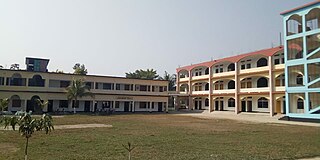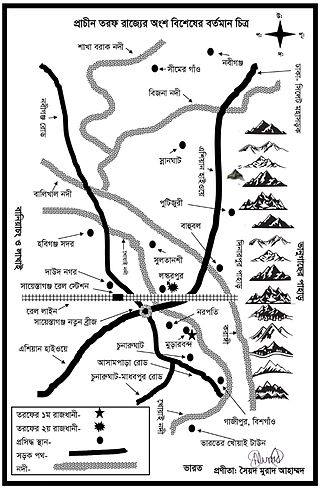
Habiganj, formerly known as Habibganj, is a district in north-eastern Bangladesh, located in the Sylhet Division. It was established as a district in 1984 as a successor to its subdivision status since 1867. It is named after its headquarters, the town of Habiganj.

The Jaintia Kingdom was a kingdom in present-day some parts of Bangladesh's Sylhet Division, India's Meghalaya state and Nagaon, Morigoan district of Assam. It was partitioned into three in 630 AD by Raja Guhak for his three sons, into the Jaintia Kingdom, Gour Kingdom and Laur Kingdom. It was annexed by the British East India Company in 1835. All the Pnar Rajahs of the Jaintiapur Kingdom are from the Syiem Sutnga clan, a Pnar clan of the Khasi tribe which claims descent from Ka Li Dohkha, a divine nymph.

Dharmapasha, also spelled as Dharampasha or Dharamapasha, is an upazila of Sunamganj District in the Division of Sylhet, Bangladesh.

Bishwanath is an upazila of Sylhet District in the Division of Sylhet, Bangladesh.

Ahmadiyya is a minority religion in Bangladesh. Although the first Bengalis to join the religion did covert during the lifetime of Mirza Ghulam Ahmad, the religion was first established as a community in the region of Bengal in 1913 by Syed Muhammad Abdul Wahed, during the Caliphate of Hakeem Noor-ud-Din. As the worldwide community is itself is an highly organised group under the Caliph, the national community works under the name Ahmadiyya Muslim Community Bangladesh or Ahmadiyya Muslim Jama'at Bangladesh. There are an estimated 100,000 Ahmadis in the country as of 2004.

The Pratapgarh Kingdom was a medieval state in the north-east of the Indian subcontinent. Composed of the present-day Indian district of Karimganj, as well as parts of Tripura State and Sylhet, Bangladesh, the kingdom was ruled by a line of Muslim monarchs over a mixed population of Hindu and Islamic adherents. It was bordered by the larger kingdoms of Kachar, Tripura and Bengal.
The Kingdom of Laur was one of the many petty kingdoms of the Sylhet region. Others included the Gour Kingdom, Ita Kingdom, Taraf Kingdom, Pratapgarh Kingdom and Jaintia Kingdom.
The Conquest of Sylhet predominantly refers to an Islamic conquest of Srihatta led by Sikandar Khan Ghazi, the military general of Sultan Shamsuddin Firoz Shah of the Lakhnauti Sultanate, against the Hindu king Gour Govinda. The conquest was aided by a Muslim saint known as Shah Jalal, who later ordered his disciples to scatter throughout eastern Bengal and propagate the religion of Islam. The Conquest of Sylhet may also include other minor incidents taking place after Govinda's defeat, such as the capture of nearby Taraf.

The Greater Sylhet region predominantly included the Sylhet Division in Bangladesh, and Karimganj district in Assam, India. The history of the Sylhet region begins with the existence of expanded commercial centres in the area that is now Sylhet City. Historically known as Srihatta and Shilhatta, it was ruled by the Buddhist and Hindu kingdoms of Harikela and Kamarupa before passing to the control of the Chandra, Sena and Deva dynasties in the early medieval period. After the fall of these Buddhist and Hindu principalities, the region became home to many more independent petty kingdoms such as Jaintia, Gour, Laur, and later Taraf, Pratapgarh, Jagannathpur, Chandrapur and Ita. After the Conquest of Sylhet in the 14th century, the region was absorbed into Shamsuddin Firoz Shah's independent principality based in Lakhnauti, Western Bengal. It was then successively ruled by the Muslim sultanates of Delhi and the Bengal Sultanate before collapsing into Muslim petty kingdoms, mostly ruled by Afghan chieftains, after the fall of the Karrani dynasty in 1576. Described as Bengal's Wild East, the Mughals struggled in defeating the chieftains of Sylhet. After the defeat of Khwaja Usman, their most formidable opponent, the area finally came under Mughal rule in 1612. Sylhet emerged as the Mughals' most significant imperial outpost in the east and its importance remained as such throughout the seventeenth century. After the Mughals, the British Empire ruled the region for over 180 years until the independence of Pakistan and India. There was a complete list of the different amils who governed Sylhet which was recorded in the office of the Qanungoh of Sylhet. However, most complete copies have been lost or destroyed. Dates from letters and seal traces show evidence that the amils were constantly changed. In 1947, when a referendum was held, Sylhet decided to join the Pakistani province of East Bengal. However, when the Radcliffe Line was drawn up, Karimganj district of Barak Valley was given to India by the commission after being pleaded by Abdul Matlib Mazumdar's delegation. Throughout the History of Sylhet, raids and invasions were also common from neighbouring kingdoms as well as tribes such as the Khasis and Kukis.
The Revolt of Radharam, also known as the Chargola Uprising of 1786 or the Pratapgarh Rebellion, was an insurrection against the East India Company which took place in 1786. It was perpetrated by Radharam, the Zamindar of Chargola, in what is now the Indian state of Assam. The revolt was one of the earliest struggles against British authority in Northeast India.
Govinda Fenchu, better known by his regnal title Gour Gobind and also known by the sobriquet Shomudro Tonoy, was the 21st and final king of medieval Sylhet's Gour Kingdom. He is described as a very conservative Hindu ruler whose reign started in 1260.
Prince Garuda, was a 14th-century Hindu prince and heir apparent of King Govardhan of Gour, he is known for his participation in the Conquest of Sylhet.
Manoranjan Rai, or more commonly known as Mona Rai was the final chief minister of medieval Sylhet's Gour Kingdom. He is most known for being named after the highest hill in Sylhet city.
Madan Rai was the penultimate chief minister of medieval Sylhet's Gour Kingdom. He was described to have been very sharp and "shrewd".
Jaidev Rai was the Governor of Brahmachal under the Twipra Kingdom.
Amar Singh, was the military general for Raja Upananda of Brahmachal, and later its king.
Shaykh Gharib Khan Nistani Afghani, popularly known as Shāh Gabru, was a 14th-century Sufi Muslim figure from the Sylhet region. Gabru's name is associated with the propagation of Islam in Osmani Nagar. In 1303, he joined Shah Jalal in the Conquest of Sylhet.

The Kingdom of Gour was one of the greater of the many petty kingdoms of the medieval Sylhet region. According to legend, it was founded by Gurak, off-shooting from Kamarupa's Jaintia Kingdom in 630. Much of its early history is considered legendary or mythological up until Navagirvana who is mentioned in the Bhatera copper-plate inscriptions. The Kings of Gour are described as patrons of Hindu revivalism in what was previously a predominantly Buddhist and animist populated land.

Taraf, previously known as Tungachal, was a feudal territory of the Sylhet region in Bengal and was under many petty kingdoms in different periods of time. It was part of what is present-day Habiganj District in Bangladesh.
Amar Manikya was the Maharaja of Tripura from 1577 to 1586.








